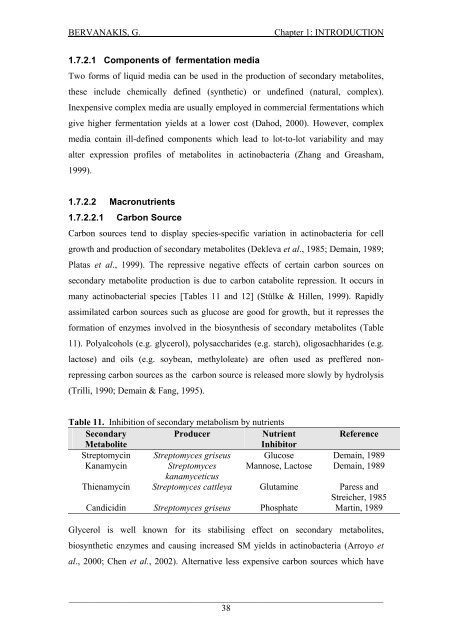Detection and Expression of Biosynthetic Genes in Actinobacteria ...
Detection and Expression of Biosynthetic Genes in Actinobacteria ...
Detection and Expression of Biosynthetic Genes in Actinobacteria ...
You also want an ePaper? Increase the reach of your titles
YUMPU automatically turns print PDFs into web optimized ePapers that Google loves.
BERVANAKIS, G.Chapter 1: INTRODUCTION1.7.2.1 Components <strong>of</strong> fermentation mediaTwo forms <strong>of</strong> liquid media can be used <strong>in</strong> the production <strong>of</strong> secondary metabolites,these <strong>in</strong>clude chemically def<strong>in</strong>ed (synthetic) or undef<strong>in</strong>ed (natural, complex).Inexpensive complex media are usually employed <strong>in</strong> commercial fermentations whichgive higher fermentation yields at a lower cost (Dahod, 2000). However, complexmedia conta<strong>in</strong> ill-def<strong>in</strong>ed components which lead to lot-to-lot variability <strong>and</strong> mayalter expression pr<strong>of</strong>iles <strong>of</strong> metabolites <strong>in</strong> act<strong>in</strong>obacteria (Zhang <strong>and</strong> Greasham,1999).1.7.2.2 Macronutrients1.7.2.2.1 Carbon SourceCarbon sources tend to display species-specific variation <strong>in</strong> act<strong>in</strong>obacteria for cellgrowth <strong>and</strong> production <strong>of</strong> secondary metabolites (Dekleva et al., 1985; Dema<strong>in</strong>, 1989;Platas et al., 1999). The repressive negative effects <strong>of</strong> certa<strong>in</strong> carbon sources onsecondary metabolite production is due to carbon catabolite repression. It occurs <strong>in</strong>many act<strong>in</strong>obacterial species [Tables 11 <strong>and</strong> 12] (Stülke & Hillen, 1999). Rapidlyassimilated carbon sources such as glucose are good for growth, but it represses theformation <strong>of</strong> enzymes <strong>in</strong>volved <strong>in</strong> the biosynthesis <strong>of</strong> secondary metabolites (Table11). Polyalcohols (e.g. glycerol), polysaccharides (e.g. starch), oligosachharides (e.g.lactose) <strong>and</strong> oils (e.g. soybean, methyloleate) are <strong>of</strong>ten used as preffered nonrepress<strong>in</strong>gcarbon sources as the carbon source is released more slowly by hydrolysis(Trilli, 1990; Dema<strong>in</strong> & Fang, 1995).Table 11. Inhibition <strong>of</strong> secondary metabolism by nutrientsSecondaryProducerNutrient ReferenceMetaboliteInhibitorStreptomyc<strong>in</strong> Streptomyces griseus Glucose Dema<strong>in</strong>, 1989Kanamyc<strong>in</strong> Streptomyces Mannose, Lactose Dema<strong>in</strong>, 1989kanamyceticusThienamyc<strong>in</strong> Streptomyces cattleya Glutam<strong>in</strong>e Paress <strong>and</strong>Streicher, 1985C<strong>and</strong>icid<strong>in</strong> Streptomyces griseus Phosphate Mart<strong>in</strong>, 1989Glycerol is well known for its stabilis<strong>in</strong>g effect on secondary metabolites,biosynthetic enzymes <strong>and</strong> caus<strong>in</strong>g <strong>in</strong>creased SM yields <strong>in</strong> act<strong>in</strong>obacteria (Arroyo etal., 2000; Chen et al., 2002). Alternative less expensive carbon sources which have_____________________________________________________________________38















